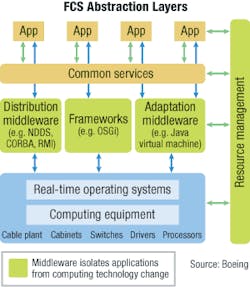Aonix hard-real-time Java technology useful for command and control
By John McHale
SAN DIEGO - Aonix engineers have demonstrated hard-real-time Java that reaches the run-time efficiency of C, which makes it able to meet the needs of command-and-control applications such as network-centric warfare, Future Combat Systems, and low-level telecommunications control-plane software, Aonix officials say. The Aonix solution, JRTK, is a hard-real-time solution also targeting the broader military, aerospace, transportation, energy, and medical markets.
The U.S. Army’s Future Combat Systems program has large System of Systems Common Operating Environment (SOSCOE) specifications for C++, Java, and Ada, says Kelvin Nilsen, Aonix chief technology officer. The Navy Open Architecture guidelines also state that all new development will be done in Java and C++, he adds.
Boeing in St. Louis is the prime contractor for the FCS program. Aonix will supply Java-compatible virtual machine technologies to LynuxWorks in San Jose, Calif.
General Dynamics Advanced Information Systems in Arlington, Va., chose the LynuxWorks LynxOS real-time operating system for FCS. A Linux compatible, open-standards operating system is required to meet the Army’s needs for real-time information and safety-criticality, LynuxWorks officials say.
FCS developers can utilize LynuxWorks’ Luminosity, a Linux, Windows and Solaris-based integrated development environment (IDE) powered by the open source Eclipse IDE platform, giving developers complete control over creating, editing, compiling, managing and debugging C/C++, Ada, and Java embedded and real-time applications.
“JRTK is the first Java technology to match the efficiency of C and offer true compliance with hard real-time constraints, while preserving the portability and scalability benefits that make Java such a popular programming language,” Nilsen says. “This new technology will offer the same developer productivity benefits to the hard real-time community that traditional Java has brought to the non-real-time domain. Typical Java development offers a two-fold increase in developer productivity and a five- to ten- fold savings in software maintenance costs in comparison to C/C++ development.”
JRTK, a hard-real-time mission-critical subset of the Real-Time Specification for Java (RTSJ) as defined by the Java Community Process, includes many efficiencies over standard Java offerings. No garbage collection is used on objects in the real-time heap. A standard subset of Java libraries is restricted with each library’s time and memory resources clearly defined. Partitioning clearly separates soft real-time components from hard-real-time components to ensure hard-real-time schedules as well as program reliability and robustness.
The hard-real-time Java technologies are designed to provide the high performance, small memory footprint, hard-real-time determinism and simplicity required for the development of FAA DO-178B certified software in commercial and military avionics applications.
The JRTK hard-real-time product complements the capabilities of the PERC soft-real-time Java platform. PERC focuses on large, dynamic, complex, soft-real-time components. In contrast, JRTK addresses the needs of low-level components with demanding throughput, hard real time, and severe memory constraints. JRTK is based on the standard for safety-critical Java being developed within the Open Group’s Real-Time and Embedded Forum.
The design of JRTK has benefited from years of supporting soft-real-time development with the PERC VM, Aonix officials say. In the past, Aonix has played an active role in helping PERC customers integrate high- performance, hard-real-time capabilities written as C components into their PERC applications.
JRTK enables these customers to apply traditional Java strengths to the development and maintenance of their performance- and hard-real-time critical components.
In 2003, the U.S. Navy commissioned a study to investigate the efficiency and scalability benefits of the JRTK architecture, Aonix officials say. In that study, a JRTK prototype was shown to ease the cost of development and maintenance and offer much higher performance than the alternative approaches of integrating C-language components using JNI (Java Native Interface) or writing low-level components using the full RTSJ, Aonix officials say.
The military is slow to change, but has growing confidence in Java and will have more as it continues to be successfully demonstrated in more applications, Nilsen notes.
The Defense Advanced Research Projects Agency (DARPA) in Arlington, Va., is studying Java and recently hosted a workshop on it, Nilsen says. The Joint-Unmanned Combat Air System is also looking at using Java, he adds.
For more information, visit www.aonix.com.

